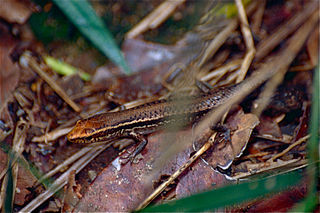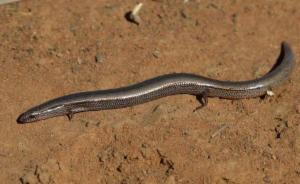
Ablepharus is a genus of skinks that contains the common snake-eyed skinks. Both their scientific and common names refer to the fact that their eyelids have fused to a translucent capsule; as in snakes, they thus are physically incapable of blinking. They are small lizards and prefer to live in the leaf litter of dry fields and hills. Their scales give them a very shiny, bronze appearance with a characteristically dark stripe down the sides of their bodies. They prey on small insects and other small mollusks.

Carlia is a genus of skinks, commonly known as four-fingered skinks or rainbow skinks, in the subfamily Eugongylinae. Before being placed in this new subfamily, Carlia was recovered in a clade with the genera Niveoscincus, Lampropholis, and others of the Eugongylus group within Lygosominae.

Menetia greyii, commonly known as the common dwarf skink or Grey's skink, is a species of lizard in the family Scincidae. The species is endemic to mainland Australia and Indonesia.

Morethia boulengeri is a species of lizard in the family Scincidae. The species is endemic to Australia and Indonesia.

Cryptoblepharus australis, commonly called the inland snake-eyed skink, is a species of skink in the genus Cryptoblepharus.

Carlia longipes is a species of skink, commonly known as closed-litter rainbow-skink, in the subfamily Eugongylinae.

Ctenotus strauchii, also known commonly as the eastern barred wedge-snout ctenotus or Strauch's ctenotus, is a small species of lizard in the family Scincidae. The species is endemic to Australia and is found throughout semi-arid and arid regions in most of Australia's mainland states except Western Australia, although one record does exist for Western Australia in 1975.

Carlia amax is a species of skink, commonly known as the bauxite rainbow-skink, in the genus Carlia. It is native to northern Australia.

Carlia gracilis, the slender rainbow skink, is a species of skink in the genus Carlia. It is native to Northern Territory and Western Australia in Australia.
Carlia munda, the shaded-litter rainbow-skink, is a species of skink in the genus Carlia. It is endemic to northern Australia.

Carlia pectoralis, the open-litter rainbow-skink, is a species of skink in the genus Carlia. It is endemic to Queensland in Australia.
Carlia quinquecarinata is a species of skink, commonly known as the five-keeled rainbow-skink or five-carinated rainbow-skink, in the genus Carlia. It is endemic to Darnley Island in Australia.
Carlia insularis, the black-throated rainbow-skink or hooded rainbow skink, is a species of skink in the genus Carlia. It is endemic to Queensland, Australia where it is found in "eastern creeks in the Wet Tropics".

Carlia rubrigularis, the red-throated rainbow-skink or the northern red-throated skink is a species of skink in the genus Carlia. It is endemic to Queensland, Australia.
Carlia rufilatus, the red-sided rainbow-skink, is a species of skink in the genus Carlia. It is endemic to Northern Territory and Western Australia in Australia.
Carlia sexdentata, the six-toothed rainbow-skink, is a species of skink in the genus Carlia. It is endemic to Northern Territory and Queensland in Australia.
Carlia wundalthini, the Cape Melville rainbow-skink is a species of skink in the genus Carlia. It is endemic to Cape Melville National Park in Queensland in Australia.
Lygisaurus tanneri, also known commonly as the Endeavour River litter-skink and Tanner's four-fingered skink, is a species of lizard in the family Scincidae. The species is endemic to Australia.

The dwarf three-toed slider or wood mulch-slider is a species of skink found in Australia. Other common names for the species include timid slider and dwarf burrowing skink. The skink is a member of the Lerista genus which are confined to continental Australia and are mostly a burrowing species of skink. The genus consists of consists elongated, smooth-scaled, Fossorial lizards that are specialized for life in the upper soils and dry leaf litter through which they slide using Lateral undulation as a form of locomotive action, giving rise to their nickname as sliders. They normally emerge of a night-time to hunt for small Invertebrates such as ants, termites and insects. If disturbed, they dive immediately into any loose substrate to avoid predation, this behavior leaves behind a distinctive disrupted wavy track that often found on sandy flats or dunes, roads and tracks.
The yellow-tailed plain slider is a species of skink located primarily in the desert areas of South Australia, Western Australia, Northern Territory and New South Wales in Australia. This uncommon lizard can be identified by its bright yellow tail, and is usually found buried under loose soil, tree stumps and leaf litter.













